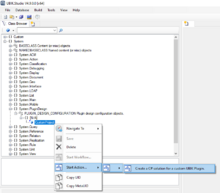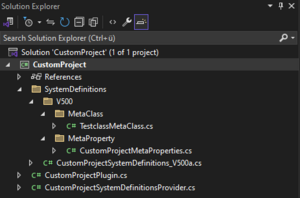Difference between revisions of "UBIK Plugin Design"
(→Exporting a C# solution for the plugin) |
(→Exporting a C# solution for the plugin) |
||
| Line 56: | Line 56: | ||
Below is an example of the resulting C# solution in Visual Studio: | Below is an example of the resulting C# solution in Visual Studio: | ||
| − | [[File:PluginResult.png|300px|thumb| | + | [[File:PluginResult.png|300px|thumb|left|C# solution in Visual Studio]] |
[[Category:Pages with broken file links|UBIK Plugin Design]] | [[Category:Pages with broken file links|UBIK Plugin Design]] | ||
Revision as of 12:19, 2 October 2025
The UBIK® Plugin Design feature allows users to create a UBIK® Plugin C# solution, including system definitions purely from customizing in UBIK® Studio.
Contents
Supported capabilities
| Feature | Version |
|---|---|
| Generation of a basic Plugin project including the Module and a SystemDefinitions stub | 5.0 Initial Release |
| MetaClasses | 5.0 Initial Release |
| MetaProperties | 5.0 Initial Release |
| Custom Class Code | 5.0 Service Pack |
| Custom Code Library | 5.0 Service Pack |
| Classifications | 5.0 Service Pack |
| Relations | 5.0 Service Pack |
| References | 5.0 Service Pack |
| Units and Unit Items | 5.0 Service Pack |
| Selective Lists and Selective Items | 5.0 Service Pack |
Usage
Creation of a new Plugin Design Configuration
The feature is accessible through the "System.PluginDesign.PLUGIN_DESIGN_CONFIGURATION" metaclass in UBIK Studio. A new Plugin Design Configuration instance can be created in the Bulk Editor to define a custom plugin context.
Adding MetaClasses to the configuration
Custom metaclasses can be added to the plugin configuration using the "SYSREL_PLUGINDESIGNCONFIG_METACLASS" relation in the Relation Editor.
Exporting a C# solution for the plugin
A C# solution can be generated for the plugin via context menu action in the Class Browser (content view style): Right-click the Plugin Configuration instance, 'Start Action → "" → Create a C# solution for a custom UBIK plugin'. This will increase the plugin version (revision), generate the C# solution and prompt the user with a save dialog for a respective .zip archive.
Below is an example of the resulting C# solution in Visual Studio:




